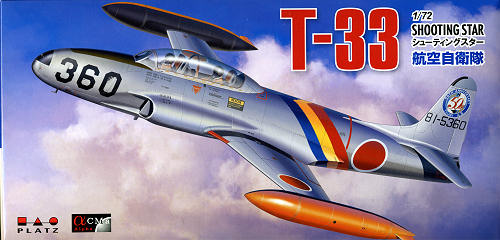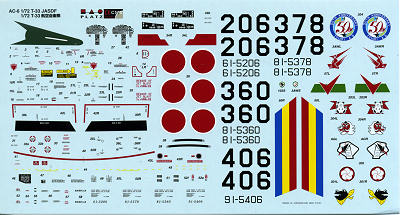
| KIT #: | AC-6 |
| PRICE: | 2200 yen from Platz Hobby |
| DECALS: | Nine options |
| REVIEWER: | Scott Van Aken |
| NOTES: | New tool kit |

| HISTORY |
The Lockheed T-33 Shooting Star is an American-built jet trainer aircraft. It was produced by Lockheed and made its first flight in 1948, piloted by Tony LeVier. The T-33 was developed from the Lockheed P-80/F-80 starting as TP-80C/TF-80C in development, then designated T-33A. It was used by the U.S. Navy initially as TO-2 then TV-2, and after 1962, T-33B. While there are no more military T-33s still in active service, the type is very popular with the jet warbird crowd. Many T-33s spent over 40 years on active service before being retired.
| THE KIT |
 The T-33 has been seeing some popularity in the last few years. Prior to this resurgence, the only T-33s kitted in 1/72 were by Hasegawa (one of their first generation kits) and Heller. Both were from the 60s and 70s. A few years back, Sword released their T-33 as part of their Shooting Star series, all of which are short run kits and all of which sold very well.
The T-33 has been seeing some popularity in the last few years. Prior to this resurgence, the only T-33s kitted in 1/72 were by Hasegawa (one of their first generation kits) and Heller. Both were from the 60s and 70s. A few years back, Sword released their T-33 as part of their Shooting Star series, all of which are short run kits and all of which sold very well.
Now we have a new tool kit from Platz, and judging by the labeling of some of the sprues, it will also be part of a Shooting star series. Of the four main sprues, two are specific to the T-33. Typical of Platz kits, the molding is top notch. The cockpit is very well done with raised detail on the instrument panels and decals to put over them if one so wishes. The seats appear to be the proper version. This is all covered by a one-piece canopy.
Since this is to be part of a series of kits, it is not surprising that the fuselage is modular. It is split about where the real aircraft is divided to gain access to the engine. There is, of course, no engine in this boxing, but there is a lot of detail on the inside of the fuselage that hints at something like this in the future. There are blanking plates for the engine intakes and a nice, long tailpipe for the exhaust.
Landing gear are well molded with all the appropriate struts. You also get separate speed brakes that can be molded open. As these usually bled down after the engine was shut off, it is an appropriate option. No indication of nose weight is give in the instructions, but wise modelers will add some just to be sure. From the look of things, this kit is not designed to be built gear up.
 Instructions are very nicely illustrated and provide Gunze paint references as well as FS 595 when appropriate. The instructions are mostly in Japanese so any advice given during the build will be illegible to many. The sheet provides markings for nine different aircraft. Basically speaking, every fighter unit had at least one T-33 to use as a hack and to allow desk pilots to get their hours. These planes could be aluminum lacquer or unpainted metal so one truly needs a photo to get that information down. The high visibility marks were often as not International Orange, especially in the later years. A superb data markings guide is part of the instruction sheet. Decals are printed by Cartograf and include not only the usual markings, but also those for inside the canopy or on the seats.
Instructions are very nicely illustrated and provide Gunze paint references as well as FS 595 when appropriate. The instructions are mostly in Japanese so any advice given during the build will be illegible to many. The sheet provides markings for nine different aircraft. Basically speaking, every fighter unit had at least one T-33 to use as a hack and to allow desk pilots to get their hours. These planes could be aluminum lacquer or unpainted metal so one truly needs a photo to get that information down. The high visibility marks were often as not International Orange, especially in the later years. A superb data markings guide is part of the instruction sheet. Decals are printed by Cartograf and include not only the usual markings, but also those for inside the canopy or on the seats.
| CONCLUSIONS |
Those wanting a quality T-33 in 1/72 scale need wait no longer. This one is a real beauty and offers just about all one would want. I can foresee this one selling very well.
| REFERENCES |
http://en.wikipedia.org/wiki/T-33A_Shooting_Star
February 2012
Thanks to www.platz-hobby.com for the preview kit. Get yours today at your local shop or have them order one for you. If you would like your product reviewed fairly and fairly quickly, please contact the editor or see other details in the